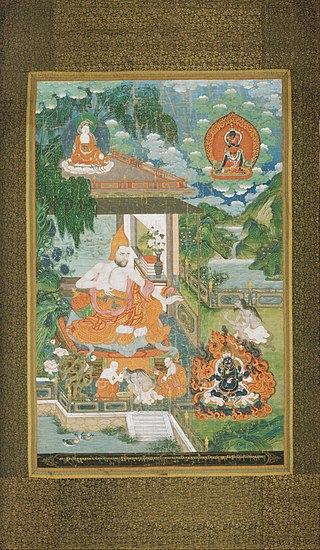"Hīnayāna" is a Sanskrit term that was at one time applied collectively to the Śrāvakayāna and Pratyekabuddhayāna paths of Buddhism. This term appeared around the first or second century. Hīnayāna was often contrasted with Mahāyāna, which means the "great vehicle".
The Bodhisattvacaryāvatāra or Bodhicaryāvatāra translated into English as A Guide to the Bodhisattva's Way of Life, is a Mahāyāna Buddhist text written c. 700 AD in Sanskrit verse by Shantideva (Śāntideva), a Buddhist monk at Nālandā Monastic University in India which is also where it was composed.

Śūnyatā, translated most often as "emptiness", "vacuity", and sometimes "voidness", or "nothingness" is an Indian philosophical concept. Within Hinduism, Jainism, Buddhism, and other philosophical strands, the concept has multiple meanings depending on its doctrinal context. It is either an ontological feature of reality, a meditative state, or a phenomenological analysis of experience.

Yogachara is an influential tradition of Buddhist philosophy and psychology emphasizing the study of cognition, perception, and consciousness through the interior lens of meditation as well as philosophical reasoning (hetuvidyā). Yogachara was one of the two most influential traditions of Mahayana Buddhism in India, along with Madhyamaka.

The Mahāyāna sūtras are a broad genre of Buddhist scripture (sūtra) that are accepted as canonical and as buddhavacana in Mahāyāna Buddhism. They are largely preserved in Sanskrit manuscripts, and translations in the Tibetan Buddhist canon and Chinese Buddhist canon. Several hundred Mahāyāna sūtras survive in Sanskrit, or in Chinese and Tibetan translations. They are also sometimes called Vaipulya ("extensive") sūtras by earlier sources. The Buddhist scholar Asaṅga classified the Mahāyāna sūtras as part of the Bodhisattva Piṭaka, a collection of texts meant for bodhisattvas.

Indian philosophy consists of philosophical traditions of the Indian subcontinent. A traditional Hindu classification divides āstika and nāstika schools of philosophy, depending on one of three alternate criteria: whether it believes the Vedas as a valid source of knowledge; whether the school believes in the premises of Brahman and Atman; and whether the school believes in afterlife and Devas.

Buddhist texts are religious texts that belong to, or are associated with, Buddhism and its traditions. There is no single textual collection for all of Buddhism. Instead, there are three main Buddhist Canons: the Pāli Canon of the Theravāda tradition, the Chinese Buddhist Canon used in East Asian Buddhist tradition, and the Tibetan Buddhist Canon used in Indo-Tibetan Buddhism.

The schools of Buddhism are the various institutional and doctrinal divisions of Buddhism that have existed from ancient times up to the present. The classification and nature of various doctrinal, philosophical or cultural facets of the schools of Buddhism is vague and has been interpreted in many different ways, often due to the sheer number of different sects, subsects, movements, etc. that have made up or currently make up the whole of Buddhist traditions. The sectarian and conceptual divisions of Buddhist thought are part of the modern framework of Buddhist studies, as well as comparative religion in Asia.

Geshe Kelsang Gyatso was a Buddhist monk, meditation teacher, scholar, and author. He was the founder and spiritual director of the New Kadampa Tradition-International Kadampa Buddhist Union (NKT-IKBU), a registered non-profit, modern Buddhist organization that came out of the Gelugpa school/lineage. They have 1,300 centres around the world, including temples, city temples and retreat centres that offer an accessible approach to ancient wisdom.
The history of Buddhism can be traced back to the 5th century BCE. Buddhism arose in Ancient India, in the modern day Lumbini, and is based on the teachings of the renunciate Siddhārtha Gautama. The religion evolved as it spread from the northeastern region of the Indian subcontinent throughout Central, East, and Southeast Asia. At one time or another, it influenced most of Asia.

Tsongkhapa was an influential Tibetan Buddhist monk, philosopher and tantric yogi, whose activities led to the formation of the Gelug school of Tibetan Buddhism. He is also known by his ordained name Losang Drakpa or simply as "Je Rinpoche". He is also known by Chinese as Zongkapa Lobsang Zhaba or just Zōngkābā (宗喀巴).

The New Kadampa Tradition – International Kadampa Buddhist Union (NKT—IKBU) is a global Buddhist new religious movement founded by Kelsang Gyatso in England in 1991. In 2003 the words "International Kadampa Buddhist Union" (IKBU) were added to the original name "New Kadampa Tradition". The NKT-IKBU is an international organisation registered in England as a charitable, or non-profit, company. It currently lists more than 200 centres and around 900 branch classes/study groups in 40 countries. The BBC describe the New Kadampa Tradition as "one of the major Buddhist schools in the UK, founded by the Tibetan-born Geshe Kelsang Gyatso."
Buddhism, also known as Buddha Dharma and Dharmavinaya, is an Indian religion and philosophical tradition based on teachings attributed to the Buddha. It is the world's fourth-largest religion, with over 520 million followers, known as Buddhists, who comprise seven percent of the global population.

Bhāviveka, also called Bhāvaviveka, and Bhavya was a sixth-century madhyamaka Buddhist philosopher. Alternative names for this figure also include Bhavyaviveka, Bhāvin, Bhāviviveka, Bhagavadviveka and Bhavya. Bhāviveka is the author of the Madhyamakahrdaya, its auto-commentary the Tarkajvālā and the Prajñāpradīpa.

Buddhism and Hinduism have common origins in the culture of Ancient India. Buddhism arose in the Gangetic plains of Eastern India in the 5th century BCE during the "second urbanisation". Hinduism developed as a fusion or synthesis of practices and ideas from the ancient Vedic religion and elements and deities from other local Indian traditions. This Hindu synthesis emerged after the Vedic period, between 500-200 BCE and c. 300 CE, in or after the period of the second urbanisation, and during the early classical period of Hinduism, when the Epics and the first Puranas were composed.

Mahāyāna is a term for a broad group of Buddhist traditions, texts, philosophies, and practices developed in ancient India. It is considered one of the three main existing branches of Buddhism, the others being Theravāda and Vajrayāna. Mahāyāna accepts the main scriptures and teachings of early Buddhism but also recognizes various doctrines and texts that are not accepted by Theravada Buddhism as original. These include the Mahāyāna sūtras and their emphasis on the bodhisattva path and Prajñāpāramitā. Vajrayāna or Mantra traditions are a subset of Mahāyāna which makes use of numerous tantric methods Vajrayānists consider to help achieve Buddhahood.
Raga is a Buddhist and Hindu concept of character affliction or poison referring to any form of "greed, sensuality, lust, desire" or "attachment to a sensory object". Raga is represented in the Buddhist artwork as the bird or rooster. In Hinduism, it is one of the five Kleshas or poisons that afflict the soul. In Buddhism, Raga is identified in the following contexts:
Dvesha is a Buddhist and Hindu term that is translated as "hate, aversion". In Hinduism, it is one of the Five Poisons or kleshas.
In Buddhist philosophy, svasaṃvedana is a term which refers to the self-reflexive nature of consciousness. It was initially a theory of cognition held by the Mahasamghika and Sautrantika schools while the Sarvastivada-Vaibhasika school argued against it.

Advaita Vedanta and Mahayana Buddhism share significant similarities. Those similarities have attracted Indian and Western scholars attention, and have also been criticised by concurring schools. The similarities have been interpreted as Buddhist influences on Advaita Vedanta, though some deny such influences, or see them as expressions of the same eternal truth.












